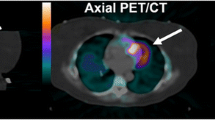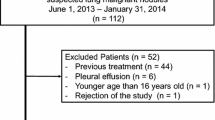Abstract
Purpose
Spatial resolution in myocardial imaging is impaired by both cardiac and respiratory motion owing to motional blurring. We investigated the feasibility of a dual cardiac–respiratory gated positron emission tomography (PET) acquisition using a clinical PET/computer tomography (CT) scanner. We describe its implementation and present results on the respiratory motion observed.
Methods
The correlation between diaphragmatic excursion measured by real-time magnetic resonance imaging (MRI) and the expansion of the chest measured with an elastic belt was studied in six subjects. PET list mode acquisitions were then performed in 12 patients, six of them injected with 13N-ammonia and six with 18F-FDG. In parallel, the ECG and respiratory signals of the patients were recorded and the list mode file correspondingly sorted using a dual gated approach. Respiratory motion of the heart was quantified by measuring the displacement between the inspiratory and expiratory images in the diastolic phase by means of intensity-based non-rigid image registration.
Results
The correlation between diaphragmatic excursion and expansion of the chest was excellent (R 2 = 0.91), validating the ability of the elastic belt to provide an adequate respiratory trigger. Respiratory signals corresponding to the chest expansion showed a large inter-patient variability, requiring adapted algorithms in order to define suitable respiratory gates. Dual gated PET series were successfully acquired for both groups of patients, showing better resolved myocardial walls. The average respiratory motion of the heart measured by PET was 4.8 mm, with its largest component in the craniocaudal direction. Moreover, a deformation of the heart with respiration was observed, with the inferior wall moving significantly more than the anterior.
Conclusion
Dual gated cardiac PET studies were performed successfully and showed better resolved myocardial walls as compared with ungated acquisitions. The respiratory motion of the heart presented a significant elastic component and was of the same magnitude as the spatial resolution of current PET cameras.







Similar content being viewed by others
References
Schwaiger M, Ziegler S, Nekolla SG. PET/CT: challenge for nuclear cardiology. J Nucl Med 2005;46:1664–78.
Kaufmann PA, Camici PG. Myocardial blood flow measurement by PET: technical aspects and clinical applications. J Nucl Med 2005;46:75–88.
Matsunari I, Taki J, Nakajima K, Tonami N, Hisada K. Myocardial viability assessment using nuclear medicine [review]. Ann Nucl Med 2003;17:169–79.
Pannu HK, Flohr TG, Corl FM, Fishman EK. Current concepts in multi-detector row CT evaluation of the coronary arteries: principles, techniques, and anatomy. Radiographics 2003;23(Suppl):S111–25.
Brambilla M, Secco C, Dominietto M, Matheoud R, Sacchetti G, Inglese E. Performance characteristics obtained for a new 3-dimensional lutetium oxyorthosilicate-based whole-body PET/CT scanner with the National Electrical Manufacturers Association NU 2-2001 Standard. J Nucl Med 2005;46:2083–91.
Rimoldi O, Schafers KP, Boellaard R, Turkheimer F, Stegger L, Law MP, et al. Quantification of subendocardial and subepicardial blood flow using 15O-labeled water and PET: experimental validation. J Nucl Med 2006;47:163–72.
Rudd JHF, Warburton EA, Fryer TD, Jones HA, Clark JC, Antoun N, et al. Imaging atherosclerotic plaque inflammation with [18F]-fluorodeoxyglucose positron emission tomography. Circulation 2002;105:2708–11.
Bengel FM, Anton M, Richter T, Simoes MV, Haubner R, Henke J, et al. Noninvasive imaging of transgene expression by use of positron emission tomography in a pig model of myocardial gene transfer. Circulation 2003;108:2127–33.
Ter-Pogossian MM, Bergmann SR, Sobel BE. Influence of cardiac and respiratory motion on tomographic reconstructions of the heart: implications for quantitative nuclear cardiology. J Comput Assist Tomogr 1982;6:1148–55.
Wang Y, Vidan E, Bergman GW. Cardiac motion of coronary arteries: variability in the rest period and implications for coronary MR angiography. Radiology 1999;213:751–8.
Shechter G, Ozturk C, Resar JR, McVeigh ER. Respiratory motion of the heart from free breathing coronary angiograms. IEEE Trans Med Imag 2004;23:1046–56.
Boucher L, Rodrigue S, Lecomte R, Bénard F. Respiratory gating for 3-dimensional PET of the thorax: feasibility and initial results. J Nucl Med 2004;45:214–9.
Danias PG, Stuber M, Botnar RM, Kissinger KV, Edelman RR, Manning WJ. Relationship between motion of coronary arteries and diaphragm during free breathing: lessons from real-time MR imaging. Am J Roentgenol 1999;172:1061–5.
Klein GJ, Reutter BW, Hol MH, Reed JH, Huesman RH. Real-time system for respiratory-cardiac gating in positron tomography. IEEE Trans Nucl Sci 1998;45:2139–43.
Yang Y, Rendig S, Siegel S, Newport DF, Cherry SR, Cardiac PET imaging in mice with simultaneous cardiac and respiratory gating. Phys Med Biol 2005;50:2979–89.
Livieratos L, Rajappan K, Stegger L, Schafers K, Bailey DL, Camici PG. Respiratory gating of cardiac PET data in list-mode acquisition. Eur J Nucl Med Mol Imaging 2006;33:584–8.
Wang Y, Riederer SJ, Ehman RL. Respiratory motion of the heart: kinematics and implications for the spatial resolution in coronary imaging. Magn Reson Med 1995;33:713–9.
Martinez-Möller A, Souvatzoglou M, Navab N, Schwaiger M, Nekolla SG. Artifacts from misaligned CT in cardiac perfusion PET/CT studies: frequency, effects and potential solutions. J Nucl Med 2007;2:188–93.
Modersitzki J. Numerical methods for image registration. Oxford; Oxford University Press; 2004.
Briggs WL, Henson VE, MacCormick SF. A multigrid tutorial. Philadelphia, PA; Society for Industrial and Applied Mathematics; 2000.
Álvarez L, Weickert J, Sánchez J. Reliable estimation of dense optical flow fields with large displacements. Int J Comput Vision 2000;39:41–56.
McLeish K, Hill DLG, Atkinson D, Blackall JM, Razavi R. A study of the motion and deformation of the heart due to respiration. IEEE Trans Med Imag 2002;21:1142–50.
Livieratos L, Stegger L, Bloomfield PM, Schafers K, Bailey DL, Camici PG. Rigid-body transformation of list-mode projection data for respiratory motion correction in cardiac PET. Phys Med Biol 2005;50:3313–22.
Klein GJ, Reutter BW, Huesman RH. Four-dimensional affine registration models for respiratory-gated PET. IEEE Trans Nucl Sci 2001;48:756–60.
Manke D, Nehrke K, Rosch P, Bornert P, Dossel O. Study of respiratory motion in coronary MRA. Proc. 9th Annu. Meeting ISMRM, Glasgow, UK, 2001, no. 1852.
Osman MM, Cohade C, Nakamoto Y, Wahl RL. Respiratory motion artifacts on PET emission images obtained using CT attenuation correction on PET-CT. Eur J Nucl Med Mol Imaging 2003;30:603–6.
Pan T, Mawlawi O, Nehmeh SA, Erdi YE, Luo D, Liu HH, et al. Attenuation correction of PET images with respiration-averaged CT images in PET/CT. J Nucl Med 2005;46:1481–7.
Acknowledgements
This project was supported in part by a research grant from Siemens Medical Solutions, Chicago (IL).
Author information
Authors and Affiliations
Corresponding author
Rights and permissions
About this article
Cite this article
Martinez-Möller, A., Zikic, D., Botnar, R.M. et al. Dual cardiac–respiratory gated PET: implementation and results from a feasibility study. Eur J Nucl Med Mol Imaging 34, 1447–1454 (2007). https://doi.org/10.1007/s00259-007-0374-9
Received:
Accepted:
Published:
Issue Date:
DOI: https://doi.org/10.1007/s00259-007-0374-9




